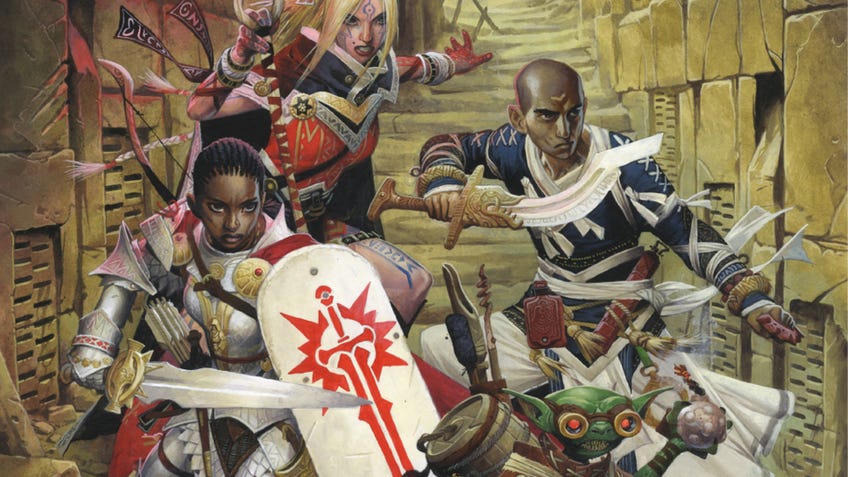Best fantasy tabletop RPGs besides Dungeons & Dragons
Excellent escapism.
Dungeons & Dragons is undoubtedly considered to be one of the best fantasy tabletop RPGs of all time, but it’s not the only one out there. With its classic sword & sorcery approach to the fantasy genre, D&D has become the quintessential roleplaying game for anyone who wants to explore far-off worlds filled with magic and danger. However, when D&D doesn’t quite scratch the right fantasy itch, what other TRPGs also feature ancient ruins and enormous lizards?
Best fantasy tabletop RPGs
- Pathfinder: Second Edition
- Romance of the Perilous Land
- Heart: A City Beneath
- Pendragon
- Mörk Borg
- The One Ring Roleplaying Game: Second Edition
- Warhammer: Age of Sigmar – Soulbound
- Mausritter
- The Witcher RPG
- Zweihander Grim and Perilous RPG
To answer this particular question, we’ve curated a list of the best fantasy tabletop RPGs, besides Dungeons & Dragons. Whether you’re looking for a dark and foreboding world where hope is a distant dream, or if you’re after a whimsical adventure filled with wonder and delight, then this list of roleplaying games should fulfil all sorts of requests. Whilst some entries on this list take inspiration from classic fantasy stories – such as Romance in the Perilous Lands – others add a more modern twist to the formula. There are also several licensed RPGs featured here, adapting the likes of JRR Tolkien’s beloved series of novels - The Lord of the Rings – and the popular video game series The Witcher.
So, pack your bedroll, rations, battle-axe and runes, as we dive into the best fantasy tabletop RPGs that aren’t Dungeons & Dragons.
1. Pathfinder: Second Edition
A revised evolution of the Dungeons & Dragons successor
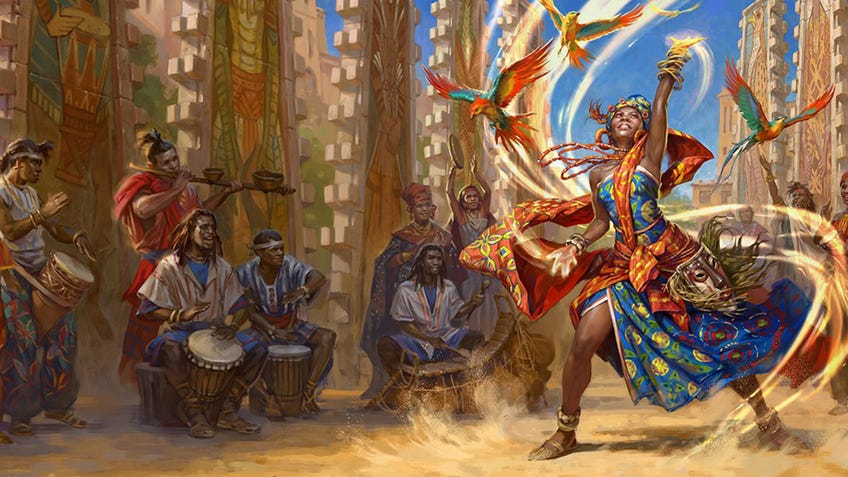
The original Pathfinder was born directly out of Dungeons & Dragons’ lineage, a spiritual successor to the game’s ‘3.5 Edition’ that built on top of the gameplay and storytelling established by the dragon game while also updating various parts of its decades-old foundation and adding its own unique ideas. Its blend of familiar and fresh proved a hit among players, leading to the fantasy RPG becoming a success in its own right.
A decade later, Pathfinder’s own second edition revised the game to streamline a number of its rules, such as making combat turns easier to manage and revisiting the options available for players when making their characters, reducing the restriction of characters’ ancestries and allowing players to spec their characters’ skills in the direction they want with minimal limitation.
The result is a version of Pathfinder that’s easier for newcomers to get into, without losing the gameplay complexity embedded at its core by its underlying tie to Dungeons & Dragons 3.5. The rulebook is still a comprehensive tome of actions, spells and world-building ideas, but using individual rules on the table is faster and easier than ever.
The game’s popularity has also led to a wealth of adventures, sourcebooks and other material both official and fan-made released over the last decade-plus, with the added ability to use D&D books thanks to the shared ruleset.
Pathfinder: Second Edition manages to offer a solid fantasy RPG alternative to Dungeons & Dragons 5E for those who miss the chewier rules of old, without feeling overly dated or off-putting to those taking their first steps into roleplaying.
Buy the core rulebook for Pathfinder: Second Edition from Amazon UK and Amazon US.
2. Romance of the Perilous Land
Explore a fantasy world inspired by classic medieval stories and folktales
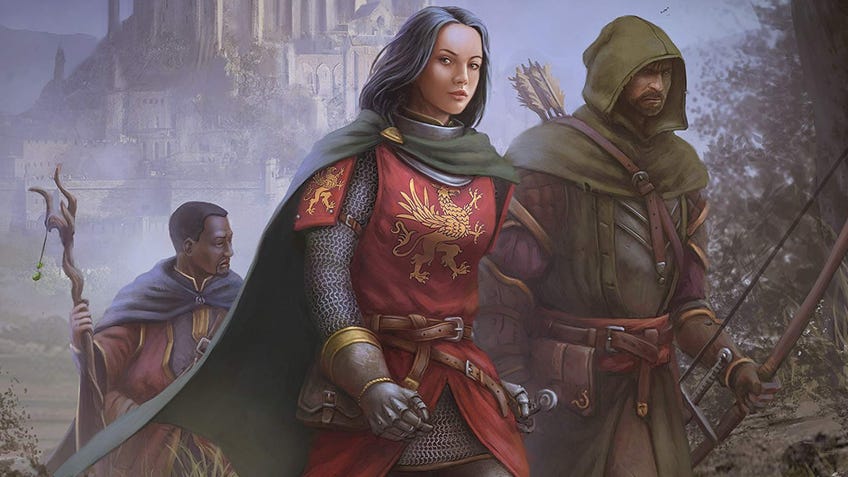
The name of this roleplaying game might imply that players will be courting royals, knights and maybe even a couple of sorcerers, but that’s not what the ‘romance’ in Romance of the Perilous Land is referring to. Instead, the term ‘romance’ is used to describe a certain genre of literature or art that focuses on the medieval values of chivalric love, adventure and being willing put the safety of others before your own. Romance of the Perilous Land takes place in a world inspired by Arthurian myths and Anglo-Saxon tales, but an inclusive one that includes diverse groups and enables players to make characters that reflect their own attributes.
Rather than focusing on the traditional swords and sorcery angle of fantasy – such as Dungeons & Dragons – Romance encourages players to indulge in the wonders of the world they’re exploring and how they can help the people that populate it. All of the player characters in Romance are morally good people who seek to fight evil on behalf of key figures such as King Arthur, Merlin or even Robin Hood, with the party heading off to defeat wrongdoers and restore peace. Similarly to D&D 5E, player characters use their various attributes, alongside a d20, in order to overcome various skill checks. However, unlike D&D 5E, players in Romance want to roll equal to or under a certain number if their character is to be successful in their endeavours.
Players are free to create characters from a range of classes – such as knight, ranger and thief – which will enable them to perform better at certain tasks than others, as well as do cool things such as casting spells or sick acrobatics. Outside of its gameplay mechanics, the real draw of Romance is its setting and approach to questing. Rather than pursuing certain quests for their own benefit, player characters in Romance are embarking on missions for their own sake and for the sake of others. Prepare to embody chivalric values in Romance of the Perilous Land.
Buy the core rulebook for Romance of the Perilous Land on Amazon UK and Amazon US.
3. Heart: The City Beneath
A sister RPG to Spire, Heart sees players exploring the underbelly of a corrupt and rotten city
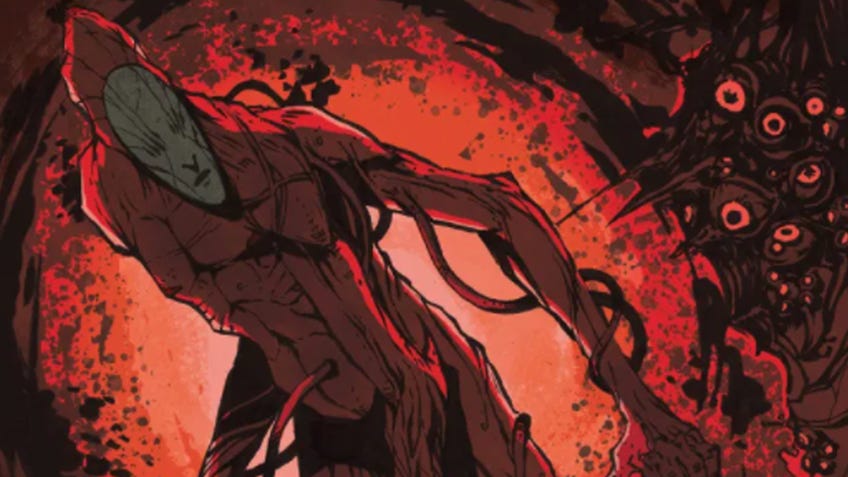
After winning about a million Ennie awards, it seems silly not to at least mention Heart: The City Beneath on this list. This game is absolutely deserving of all of the praise it’s gotten. Heart was co-created by duo Christopher Taylor and Grant Howitt – the designer of the infamous Honey Heist RPG in which players are criminal bears. This roleplaying game is a sort of sister title to a previous RPG from Taylor and Howitt by the name of Spire, in which all High Elves in a fantastical city are horrible, racist bastards. Some of the city’s less fortunate inhabitants have escaped into the unknowable, eldritch nightmare that is The City Beneath.
Mechanically Heart uses a pretty straightforward system in which you’ll be collecting pools of d10s, and determining the result of your actions based on whatever your highest result is. Your character has things they’re good at and domains in which they thrive, for each one you have that’s relevant you’ll add more dice to your pool. It’s got a few nuances, like the multiple types of stress you can suffer, but in general it should be pretty easy for newer players to wrap their head around - especially with an experienced games master.
Outside of the obviously fantastic world building that the book has throughout, the thing that shines the most in Heart is the cast of characters you’ll be able to create. From the buzzing bee witch known as the deep apiarist, the body altering cleaver that takes the idiom ‘you are what you eat’ disturbingly literally, the character classes in Heart are so fantastically specific. Despite the standard fantasy backdrop that the world of Heart and Spire suspend themselves in, these games couldn’t be any further from the standard fantasy fare. If you’re looking for something truly different and wonderfully evocative, then the world of Heart awaits you with open tentacles.
Written by Wheels
Buy the core rulebook for Heart: The City Beneath on Amazon UK and Amazon US.
4. Pendragon
Epic Arthurian fantasy told over generations
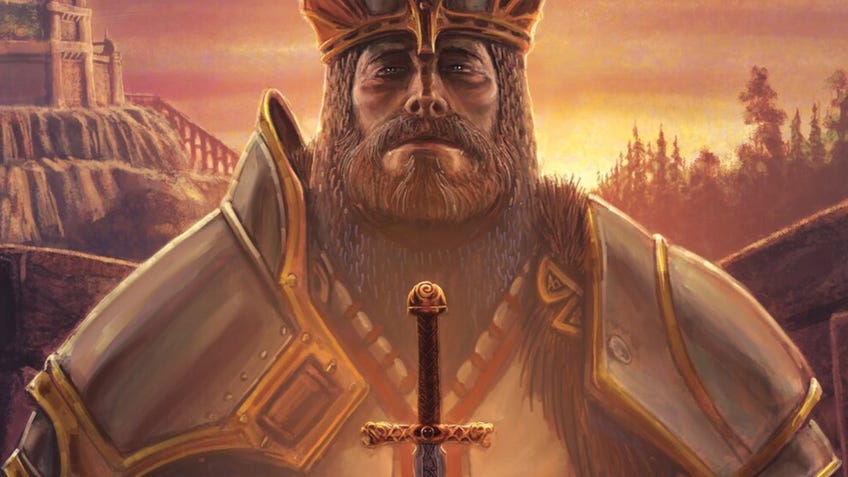
As well as its setting’s roots in classic Arthurian folklore, fantasy RPG Pendragon has its own link to roleplaying royalty, emerging from the mind of one of the most influential RPG designers of all time: Greg Stafford, a key figure behind 1970s fantasy RPG RuneQuest and the hugely influential horror RPG Call of Cthulhu.
Considered Stafford’s magnum opus – and the late designer’s own favourite among his many games – Pendragon is still a fantasy RPG like no other, almost 40 years after it first hit tables.
The game is set in a fantasy world steeped in the legends of King Arthur and his Knights of the Round Table. Like Arthur’s knights, players set out on quests based around political or spiritual pursuits, rather than prowling the closest dungeon for loot.
Rather than conventional stats such as strength and dexterity, characters are created through a combination of virtues and passions, which influence how they may act in certain situations – and open up the potential for temptation and failure as they remain beholden to ideas such as honour, like in traditional Arthurian stories.
Pendragon’s most unique and inventive element is its multi-generational storytelling, which allows players to live out the lives of multiple characters over a number of years and generations – possibly even playing the descendants of their previous characters. While fantastical adventures are a key part of the RPG, just as important are aspects such as romance, marriage and everyday life between quests – something rarely seen in RPGs such as D&D.
Pendragon’s epic scope and complex painting of a fantasy-historical world remain unmatched even today. The game has seen a number of editions over the years; its latest full release is an updated version of its fifth edition, with a sixth iteration described as Stafford’s “ultimate edition” due for release in the future – a set of preview rules is currently available.
Buy the core rulebook for Pendragon: 5th Edition on Chaosium.
5. Mörk Borg
Struggle against the darkness as the world comes an end in a bleak and brutal RPG

Whilst many fantasy roleplaying games are designed to enable their players an escape from their dreary, mundane lives, Mörk Borg offers no such thing. Released to critical acclaim in 2020 – winning two prestigious Ennie Awards for product of the year and best writing - Mörk Borg presents a world that is finally coming to its end, after a long and brutal history of violence, tragedy and death. The aim of playing Mörk Borg isn’t necessarily to ‘win’, it’s more about trying to find a glimmer of redemption in an otherwise miserable and cruel universe. This feeling is effectively conveyed through the rulebook’s striking art-style and gruesome descriptions.
It is also communicated through Mörk Borg’s rather unforgiving gameplay system that is more than willing and able to inflict all sorts of harm on the player characters. See, characters in Mörk Borg aren’t ‘good people’ per say, but they could be people at least trying to be better. But this is made exponentially more difficult by The Calendar of Nechrubel – a system that gradually tracks the terrible series of events leading up to the end of the world – the bestiary of terrifying creatures ready to kill and systems that govern elements such as the collection of occult powers player characters can perform, with failure resulting in catastrophes of immense proportions.
But that’s the main appeal of playing Mörk Borg, the potential for things to go incredibly wrong. You can’t go into playing this RPG without the complete understanding that your character will fail in the most tragic way. But once you’ve accepted your character’s fate, then you can really begin embracing the misery and terror that Mörk Borg instills in its players. Mörk Borg is actually a refreshing change from the normal fantasy RPG experience, one that is unlikely to leave your head any time soon.
Buy the core rulebook for Mörk Borg on Amazon UK and Amazon US.
6. The One Ring Roleplaying Game: Second Edition
One Lord of the Rings RPG to rule them all?
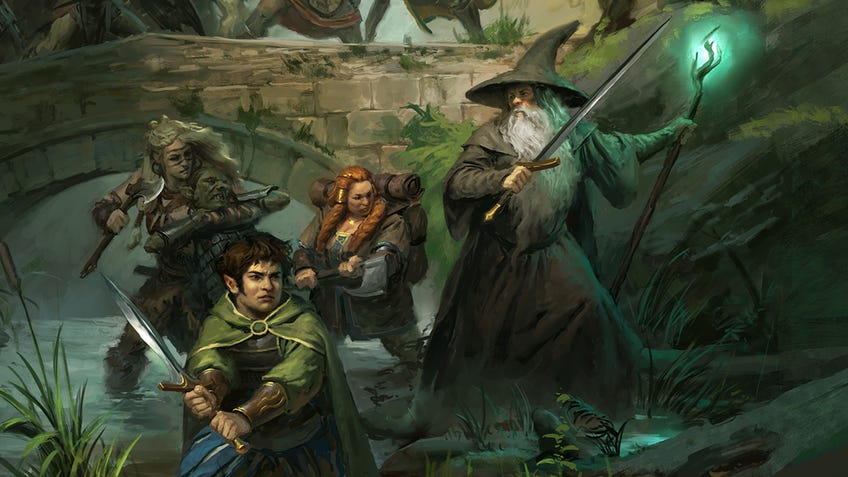
The Lord of the Rings sits alongside Dungeons & Dragons as one of the key influences on countless modern fantasy RPGs today – and fantasy as a whole, for better and worse – so it’s only natural that Tolkien’s epic tale of hobbits, magical rings and long journeys across Middle-earth has been adapted for the tabletop.
The latest outing for the Lord of the Rings in roleplaying form is The One Ring: Second Edition, an update to the standalone RPG first published by Cubicle 7 more than a decade ago. (For those looking to explore Middle-earth using the familiar rules of D&D 5E, the separate Adventures in Middle-earth sourcebook has you covered.)
Now in the hands of Tales from the Loop and Alien: The RPG studio Free League, The One Ring 2E updates the original game’s rules while shifting the focus of its well-trodden setting to Eriador, the region of Middle-earth that includes the hobbit home of The Shire.
While players can still embark on epic quests like those of Frodo and the Fellowship of the Ring, The One Ring typically puts more weight on smaller drama and encounters than events spanning the whole of Middle-earth. The game’s Adventure phase sees players dealing with encounters - whether by fighting, or less violent means - before they rest up and prepare during the separate Fellowship phase.
As you’d expect from a game steeped in Tolkien’s work, there’s plenty of time spent on the road as a party, with a set of travel rules making treks across Middle-earth as important and memorable as battles or puzzles. The players can even encounter familiar faces from The Lord of the Rings, whether they’re sponsoring the party’s travels – with possible partners including Bilbo and Gandalf – or gathered through dedicated rules for holding councils, like the Fellowship’s meeting in Rivendell.
The One Ring is the ideal RPG for those looking to venture back into a familiar fantasy world, while also getting the chance to discover and explore new corners of Middle-earth as their own creations. In many ways, fantasy RPGs don’t get much more fantasy than this.
Buy the core rulebook for The One Rule: Second Edition on Free League Publishing.
7. Warhammer: Age of Sigmar – Soulbound
Fight monstrous foes and uncaring gods in a spin-off RPG from the popular miniatures series
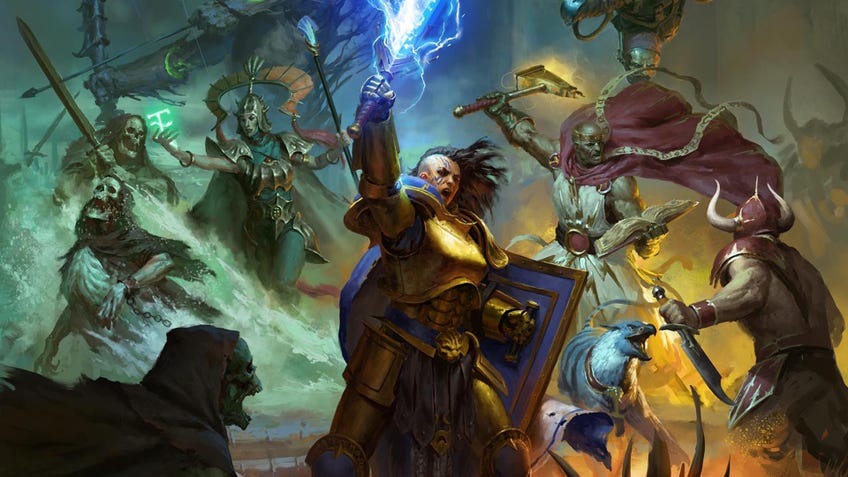
Warhammer Fantasy might be the most recognisable of the miniatures series’ RPG spin-offs, but it’s certainly not the only one worth taking a look at. Based in the universe of skirmish game Warhammer: Age of Sigmar, Soulbound sees players becoming pawns in the games of leaders and gods far mightier than themselves. Age of Sigmar is a universe made up of The Mortal Realms, which are eight different worlds – some inspired by magic, others more by steampunk or horror - each populated by people and monsters alike. Whilst the common folk struggle to survive, the deities and rulers of each realm are in almost constant conflict with one another, with the player characters charged with exploring these lands to fulfill the wishes of the world’s more merciful gods.
Becoming Soulbound means tethering yourself to other people in your order, ensuring that as long as someone is still alive everyone else can come back from death. As members of the newly revived Soulbound order, the player characters will be protected from Nagash – god of death – through the souls of their comrades. This concept adds weight to player characters’ bonds with one another by making the saying ‘putting my life in your hands’ quite literal. The universe of Age of Sigmar is a dark and dangerous place, meaning that sometimes the only light that someone can find is with their friends and companions. It’s funny how such a gritty and morose world can inspire such compassion.
When creating their characters, players will be able to choose from a variety of different archetypes based on the rival factions that call The Mortal Realms their home. From the righteous Stormcast Eternals to the strange Deepkin and actual sentient giant trees, there is plenty of opportunity to make a party of absolute weirdos who someone find common ground with one another, simply because they have to. Start your journey into the world of Age of Sigmar with the Soulbound RPG.
Buy the core rulebook for Warhammer: Age of Sigmar - Soulbound on Amazon UK and Amazon US.
8. Mausritter
Big adventures for little mice in a charming fantasy RPG.
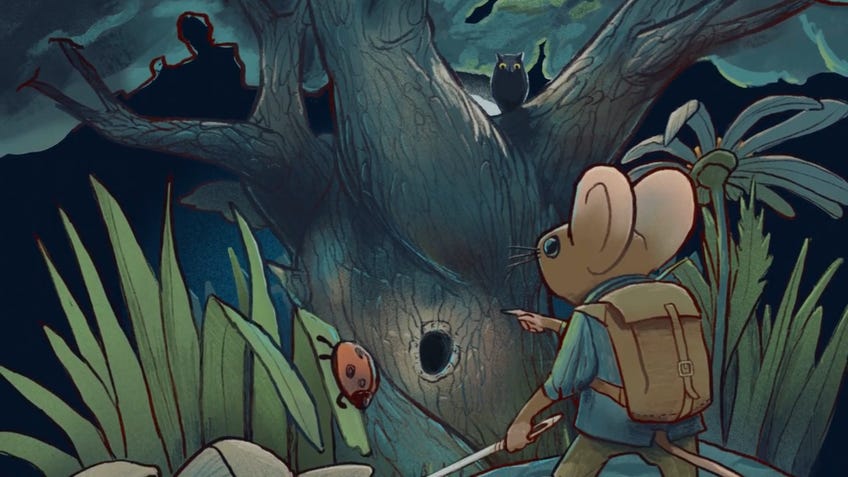
Swap Dungeons & Dragons for Rurality & Rodents, and you end up with Mausritter. Isaac Williams’ delightful fantasy RPG follows in the pawprints of classic tales such as Redwall, roleplaying game Mouse Guard and board game Mice and Mystics as players become little mice on a big adventure.
Mausritter’s gameplay builds on the system used in indie title Into the Odd, part of the OSR – old-school renaissance – genre of roleplaying games inspired by the early days of D&D and other 1970s RPGs. Compared to the crunchy rules of early D&D, however, Mausritter is a decidedly beginner-friendly experience with a much lighter set of rules for players to learn.
The game uses a clever inventory system where equipment such as armor and weapons, along with other items collected on players’ journeys, are physical tiles that fill a limited number of squares on their character sheet – making it easy to track how much your character can carry without complicated encumbrance rules. Negative effects such as exhaustion can also take up slots, providing a way of adding interesting gameplay and storytelling complications without pages of rules to remember.
Resolving tests is just as simple, with just three core traits - strength, dexterity and will – that are checked against a single d20 roll. Mausritter’s inventive magic system lets players’ mice cast spells, recharging their uses through a series of rituals that are often entertaining – such as giving a cat “a gift it truly desires”.
Balancing its charming theme and setting with beginner-friendly gameplay and an inventive twist on classic roleplaying, all in the space of a few dozen pages, Mausritter is a fantasy RPG that’s ideal for players looking to return to the days of early D&D or those brand new to the hobby. It’s sure to set your whiskers twitching.
Buy Mausritter on Itch.io.
9. The Witcher Tabletop RPG
Enter the world of the hit video game series in this tabletop RPG adaptation

The Witcher franchise has certainly gotten a lot more popular over the last decade or so. Originally released as a series of fantasy novels by Polish author Andrzej Sapkowski in the 1980s, the books were eventually adapted into a trilogy of video games culminating in The Witcher 3: Wild Hunt, which is considered to be one of the best RPG video games of all time. Now that the Netflix series has reached its second season, there’s never been a better time to get into The Witcher franchise in every way you can – including a tabletop roleplaying game from the publisher behind the Cyberpunk TRPG series.
The Witcher TRPG takes place in a fantasy world populated by humans, elves, dwarves, sorcerers and monsters. Once a relatively normal medieval land, the continent became the landing zone for portals which brought in all sorts of strange beings and creatures. Players control characters living in this world during the middle of the third Nilgaardian War, a huge conflict that drags rulers and ordinary folk alike into it. Whilst the titular Witcher himself – Geralt of Rivia – is off recovering his memories and searching for his lost adopted child, the player characters are free to pursue their own various adventures. The beauty of the Witcher RPG is that players are tied into exploring any set paths, instead, they can choose to get involved in both enormous questlines, such as the Nilfgaardian War, or incredibly local concerns like a village that’s getting terrorised by some meddlesome creatures.
Whilst players can create their own Witcher character – people who have undergone brutal experiments to prepare them for monster hunting – they can also make a pretty standard soldier, or a craftsperson, or a sorcerer, or even a travelling bard, if they fancied following around a grumpy Witcher themselves. Playing the Witcher RPG is a great way to discover more about the world outside of Geralt’s own adventures, with there being more than enough to do considering the sheer size of the continent and its possibilities.
Buy the core rulebook for The Witcher TRPG on Amazon UK and Amazon US.
10. Zweihander Grim and Perilous RPG
Cut through the dangers of a medieval world filled with peril in a dark fantasy RPG
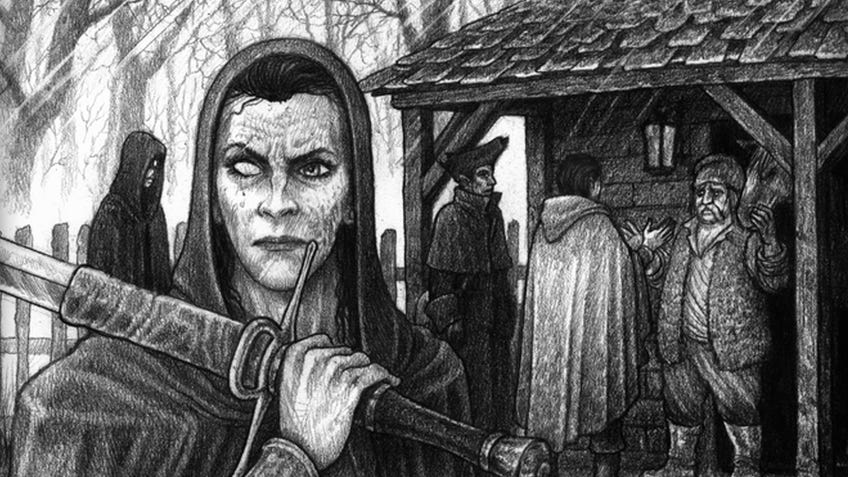
Inspired by the likes of George RR Martin’s A Song of Ice and Fire series and the Gentlemen Bastard novels by Scott Lynch, the Zweihander Grim and Perilous RPG is all about realism – which seems an odd thing to say about a fantasy roleplaying game. However, the kind of fantasy we’re talking about here is far from the escapist settings presented by RPGs such as Dungeons & Dragons. Instead, Zweihander is all about the many dangers of a world run by greedy and ambitious rulers, populated by monsters and lacking in any modern understanding of medicine. Zweihander – an RPG that’s been awarded multiple Ennies - is the kind of game where you’re as likely to die from a leg wound as you are from fighting a terrifying creature.
Player character won’t just be facing danger from monsters, they can choose to get into all sorts of trouble from full-blown medieval wars taking place in big open fields, to court intrigue between ambitious members of the landed gentry. Wherever players decide to find their thrills in Zweihander, they’ll surely be faced with one or two difficult decisions, ones where they’ll likely be made to pick between two otherwise unfortunate outcomes. The world of Zweihander is a harsh one, where the player characters are trying to make some small amount of difference in an otherwise grim situation.
The core of Zweihander is enabling players to approach its dark and nasty world in whatever way they want, whether that’s deciding what their moral code is or which pathway to take through a particularly creepy forest. Whatever players choose, there will be consequences waiting for them. Crossing someone will likely end with a dagger in the back, whereas making a wrong turn in a shadowy wood might see a character running away from a pack of hungry wolves. Be careful where you tread in the world of Zweihander because it’s ready and more than willing to bite back.
Buy the core rulebook for Zweihander Grim and Perilous RPG on Amazon UK and Amazon US.
